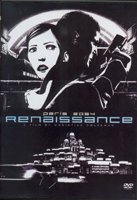
Arch
443/646: Architecture and Film
Fall 2008
Renaissance
2054 (2006)
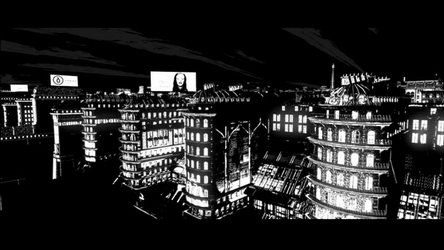
 |
Arch
443/646: Architecture and Film Renaissance
2054 (2006) |
 |
Discussion Questions:
Remember, your images are ABOVE your name.
Please answer the questions below. Use paragraph form. Your answer should be around 400 words. Email me your responses in Word .doc format to: tboake@sympatico.ca I will be posting these each week after the class. You should be prepared to deliver your answer in class -- but paraphrase, do not read it. THINGS TO KEEP IN MIND WHEN ANSWERING THESE QUESTIONS: I am looking for general observations about the film and the relationship to any aspect of madness that we have examined. The images attached to your "words" are to clarify the intention but are not meant to be action specific. We will be tying these questions to Paprika next week. |
x |
|||||
| 1. | 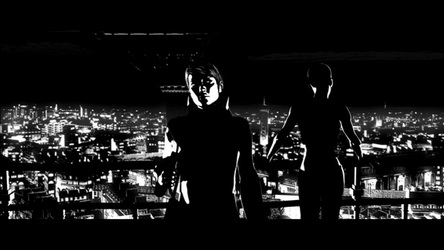 |
||||
Andrew Azzopardi Within the film renaissance, the use of both black and white is the dominant feature which both is used to define the cinematography, but also the atmosphere of the film as a totality. The film is primarily composed as a black and white film, the difference is that the black and the whites are pushed to an extreme- we generally only see black and white, and no grey tonal values. This sets up an interesting contrast within the film, one which is defined by limits. The limits are the atmospheres of future Paris; the city has become the quintessential future city- layers, visible depths, massive transportation networks, and crime. Black is used as a means to large amounts of hide information of Paris, where white becomes the only visible feature within the film. This hiding creates a sense of continuous chaos within the city- an individual or spectator never has any indication of what may be behind the foreground, or deep within the background. Everything within the city becomes unknown territory, nothing feels safe and familiar, rather it invokes a sense of unease. It is a similar approach used in Tim Burtons ‘Batman’- By de-saturating the scenes and composing the sets as if the film where a cartoon, Tim Burton achieves the same effect of the continuous unknown within his film.
|
|||||
| 2. |
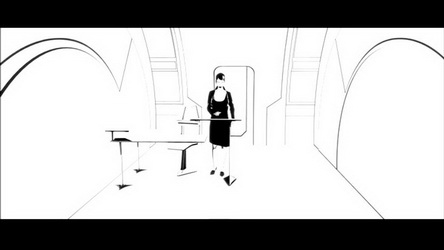 |
||||
Tyler Bowa |
|||||
| 3. | 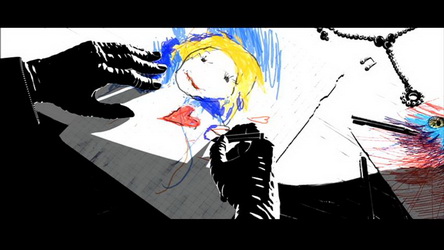 |
||||
Martin Chow The use of colour into an otherwise black and white film is intended to highlight elements of certain significance, or a departure from the norm. In Renaissance, the future world of Paris is depicted as a emotionally and psychologically cold, dark place. All the characters, (up to the scene with colour), are normal, relatively predictable adults that operate logically and fit into their world. As such, their appearances, faces and actions are rendered in the same way as their setting, with highlights and shadows of faces that merge seamlessly into the background. The introduction of the character Klaus coincides with coloured rendering of his crayon drawings. The colour catches the attention of the viewer, who has been accustomed to interpreting the film visually in terms of black and white. Immediately one senses the significance of the moment, which when combined with the introduction of child-like elements that contrast with the slick adult world it is in, definitely jumps out from the ordinary. Since black and white is associated with the "regular" portion of the film, with regular people and perspectives, the colour in the drawings enhances its infantile qualities, and alerts to a sense of abnormality. It's juxtaposition with the black glove of an adult holding the crayon indicates madness in the person. Much about Klaus is unknown, but what the viewer sees on the drawings are physical hints of the workings of a mind that operate outside of the normality represented by black and white. It shows that Klaus is perhaps a more primative being, and does not see the world with the same lens as the viewer or the other characters. The implications of madness makes this character unpredictable such that the scene is frought with suspense and anticipation of some kind of revelation.
|
|||||
| x | 4. | 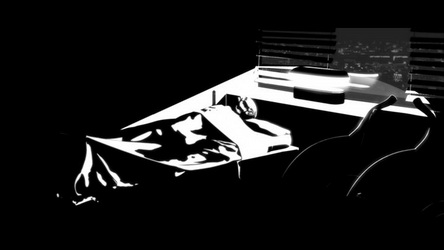 |
x | ||
Jamie Ferriera Contrast is the difference in visual properties that makes an object (or its representation in an image) distinguishable from other objects and the background. In visual perception of the real world, contrast is determined by the difference in the color and brightness of the object and other objects within the same field of view. (wikipedia) Renaissance 2054: heavily styles the entire film in this manner in order to emphasize and direct the audience in terms of tone and the balance of light and dark in composition. By removing the gray, the level of uncertainty that exists in that gradient allows everything to become more definable and clearer, where doubt is removed. This removal makes the images harder to distinguish detail and works well by that since it makes movement and action more engaging and direct as tone becomes distinguishable with levels of intensity. The representation of Paris receives this complement of creating a setting where crime and deception is rampant.
|
|||||
| 5. | 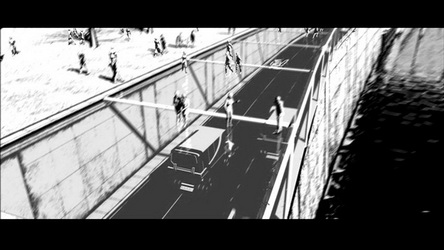 |
||||
Meghan Galachiuk |
|||||
| 6. | 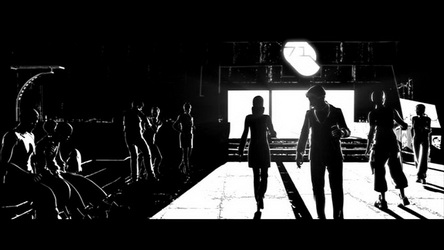 |
||||
Sarah Hawley |
|||||
| 7. | 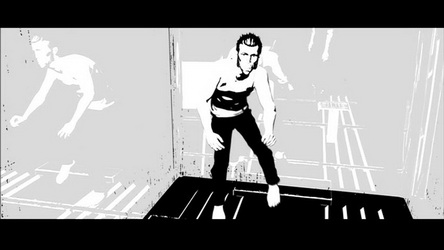 |
||||
Fernie Lai The film Renaissance has achieved a characteristic of madness in its representation of the future world using normal cinematic techniques, but enhanced in the nature of black and white animation.
|
|||||
8. |
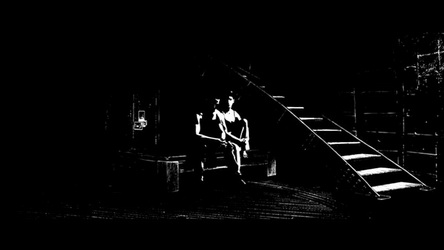 |
||||
Eric Lajoie The use spotlighting helps to create intimacy, and to help guide our attention. I think this ties into what the director was saying about it being like a theatrical performance, with a big stage they use a spotlight to essentially shrink the space, and focus our attention on certain characters. For example, in the image accompanying this question, only the people, the bench and chair are highlight. This allows us to focus on the subtleties of their motions, instead of being caught up in what is around them. In a black and white film, especially one of this magnitude, where there is a lot going on at times, I believe it would be easy to get lost in scenes without the use of spotlighting.
|
|||||
| 9. | 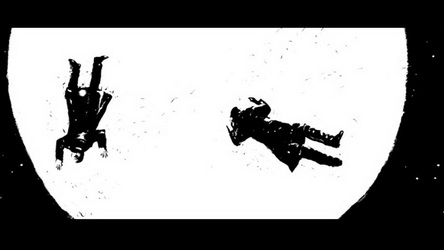 |
||||
Andrea Lam Renaissance is a movie full of extremes and contrasts. The angle at which the scenes are shot is no exception. Contrasting between black and white, corruption and purity, love and hate, low angle and high angles – to name a few – give the film an edge that would be very difficult to achieve without the use of technology and digital re-mastering, should it have been shot with live sets and real actors. The level of dynamicism that is added by taking the shots from such high angles gives the viewer almost a ‘Grand Canyon’ feel to most of the shots, with buildings, people, and the entire city in a view that is not normally possible to the every day individual. This gives a dizzying effect and takes the viewer out of the situation-at-hand and almost relieves them of the madness ensuing. The use of high angle shots goes hand-in-hand with the transition of scenes. The zooming out to or the zooming in from a high angle was never part of the plot, where say the character was high up in a helicopter, looking down (with the exception of one scene in the end). They were always used to enter or exit scenes. Another concept that the high angle addresses is the one of security. Avalon is watched and recorded from every corner. By shooting at high angles, it gives the viewer the satisfaction of seeing what ‘the eyes in the sky’ see as well. Surveillance shows up many times in the film – Avalon’s security, the police, Ilona’s captor, the chase scene with Bislane – and always raises the question as to the necessity of it. Does surveillance help the city? Or does it corrupt it further? Who does surveillance protect – the viewer or the viewed? In the case of Avalon, it is certainly the viewers who put surveillance in place that benefit from it. The police use surveillance to find the missing people and it comes down to, once again, the struggle between good and evil.
|
|||||
| 10. | 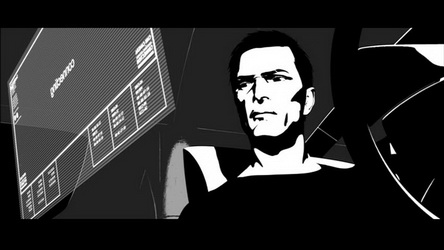 |
||||
Bi-Ying Miao The use of low angle shots in Renaissance 2054 is used in various ways to highlight the disorienting madness of the depicted futuristic Paris. This filming emphasizes the high-contrast nature of the film is all its darks and lights, pasts and futures, and life and immortality. By directing the camera upward at a particular scene, the audience is placed at a very unnatural position while the subjects of the scene are enlarged to take on a stronger presence. The dehumanization in the perspective reflects the exaggerated obsession with beauty and the cruel experimentation to achieve it of future Paris in the film. In addition, the inhuman angle lends to the idea of surveillance in the film where the viewer becomes abstracted to the perspective of a recording device. Again, the unnatural quality of the low angle shot further emphasizes the quality of the film. From a technical standpoint, the low angle approach reveals a hierarchy of information from foreground to background. In the provided image, the main character dominate the screen. The low camera angle not only places Karas the most authoritative position as the driver, his environment is projected in an almost exaggerated perspective. In this case it is the supporting technology of the future world and the force of justice in the film that gets emphasized by virtue of the low angle shot. In this way, the filming technique helps to create a relationship with the scene by establishing a extreme perspective view. It seems that depending on the character and the severity of the low angle, the character in question could either be seen as an oppressive corporate power to an authoritative figure of justice. Lastly, the low angle technique further brings out the multi-level infrastructure of above- and below-ground paths that are visually transparent. The chase-scene through this infrastructure in the greatly benefits from the use of low angle in highlighting the vertical stacking of circulation routes in the city and therefore, emphasizing the futuristic quality of the film.
|
|||||
| 11. | 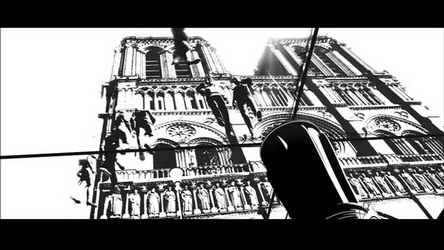 |
||||
Andrea Murphy The presence of such recognizable icons in Renaissance are unlike what we have seen in most of the previous films involving madness. Most of the other films have used built sets or ambiguous or disorienting location shooting. Renaissance, however, is recognizably located in Paris and has references to the icons of the city, including the Eiffel Tower, Montmartre, Sacré Cœur, Notre Dame, and the Seine River. The digital makeover of Paris into a futuristic technologically advanced city is surprisingly parallel to the plot line of the Avalon Corporation seeking to find the key to immortality.
|
|||||
| 12. | 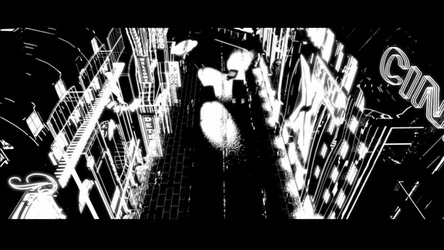 |
||||
Morgan O'Reilly In the Paris of 2054 new development has created an entirely new city on top of the old city. Rather than an integration of the new with the old, essentially the old city has become the new ground plane into which the new very high tech looking developments are plugged. Large steel legs create a separation between the levels and in some special instances, such as Notre Dame and the Eiffel Tower, the ground plane is enclosed by a layer of glass. It is obvious that in the process of development it was decided that these areas are special instances, which deserve preservation and should not touched unlike the majority of the old city. Other than these special instances, rarely do you see the old city actually being inhabited. Most of the time the characters are shown within the raised level, on platforms and within glass rooms that hover over the old city. People are also often shown to inhabit La Defense rather than the old area of Paris.
|
|||||
| 13. | 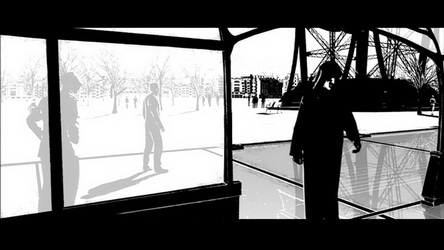 |
||||
Sue Anne Tang Renaissance incorporates layers visually with the graphics and the plot. Graphically, the layers of the scenes add visual depth to the characters and the scenery. An example would be the ‘virtual’ nature scene where the layers of vegetation emerge around Ilona when she awakens. Visual depth emerges through the layering, so there is differentiation between the foreground, middle ground and background. The layer in the foreground, which is usually the main characters, provides a focal point for the viewer.
|
|||||
| 14. | 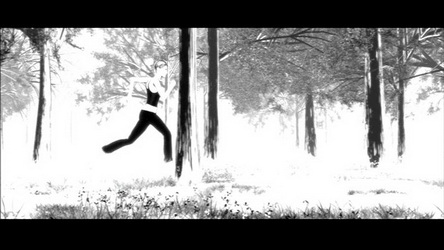 |
||||
Meredith Vaga In the Paris of Renaissance all movement of each individual is monitored and recorded by the pharmaceutical giant Avalon. The prevailing attitude of the society itself, as propagated by Avalon, is towards youth and beauty, and viewing those as the most coveted commodity. Through this, it is inferred that permanence (i.e. immortality) is the ultimate aim of the corporation, who ominously promises to be with you “for life.” Through the way in which the society has evolved, nature has been rejected from the city itself, as it does not fit into the world order. Nature is generally uncontrollable, which is obviously not a desirable quality for a corporation who strives to control everything. More importantly, the defining characteristic of the natural is the way in which it is constantly undergoing a process of renewal in the life/death cycle, which permeates through all levels of the world. The resulting move to virtually eliminate nature from the city is then reflected in the film in three key ways. The first way nature is represented in the film is the most understated: as an aspect of the construction of the New City of Paris, one can see the Seine has become essentially another layer of the ancient infrastructure that pervades and under-lays the entire city. This ‘underbelly’ of the city is half buried under the entire system, and is interestingly enough the place in which Ilona is held after being kidnapped. Which leads directly to the second key way nature is utilized in the film: the space Ilona is kept for the duration of the film is an enclosure through which nature in the form of a forest is virtually constructed in seemingly endless space. This constructed infinite space is very disorienting, – endless trees – and disengages both her and the audience from understanding a sense of place. It is also interesting to note that those who reside outside of the system created this artificial construct. This construct is still, however, a part of the built world. The final instance of nature in the film is seen when Karas goes to the apartment, where the forest plays an integral part in the resulting fight sequence as a method to both reveal and conceal – motifs that occur throughout the film in relation to the cat and mouse game played between Karas and Avalon. This instance of nature is, as far as the audience is aware, the only ‘real’ nature left in a relatively natural state. Furthering the idea that nature is not conducive to control by the governing powers, this brings up an interesting dichotomy not dissimilar to that found in the film Equilibrium in regards to the hypocritical tendencies of those in power.
|
|||||
| 15. | 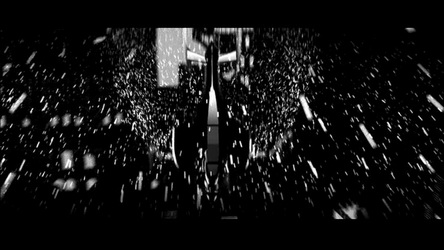 |
||||
Anna-Joy Veenstra There is a fairly steady rain throughout the movie Renaissance with a mix in of snow every once in a while. Obviously there is a large attempt to make the film seem more ‘real’ with the addition of weather always in the background. However, this occurrence gives an unsettling vibe, why is it always raining in Paris 2054?
|
|||||
| 16. | 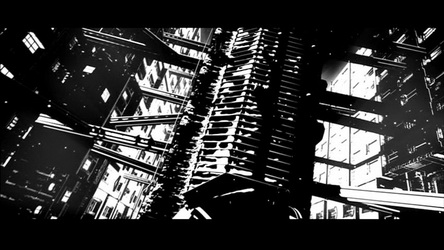 |
||||
Rui Wang Because Renaissance is such a high-contrast black and white film, materiality - especially the textural qualities - is extremely important in generating interesting sets and atmospheres. In typical films, dirty, gritty sets contrast with the clean, smooth to produce unique, subtle mood shifts appropriate to the plot and the characters. What Renaissance does and needed to do was to crank up the difference and kill the subtly all together. As a grimy animated film-noir tale, Renaissance could not afford to remain in the gray-area of good-guy/bad-guy dichotomies. The images are crystal clear in that the director has chosen exactly what gets highlighted and what does not. Thus the materials have to be either highly accentuated, such as the highly rusticated stones and complex steel frames seen across the city; or they need to be extremely slick, as seen in the Avalon headquarters. So there is either roughness or there is sheen. Sometimes when it rains on the buildings there is both!Both qualities look well in high-contrast and both are easier to represent than more subtle material differences. This is an important component to the movie as a whole. The film offers little in the way of nuance, which is unfortunate in a detective story set in such a well developed futuristic version of Paris. More focus on the details and less on the visual style would have benefited the movie in the long run - turning it from a visual stunner that quickly grows old to a truly great sci-fi genre film. As is, the sheer relentlessness of the contrast begins to wear on the senses and one begins to long for those gray moments to rest.
|
|||||
| 17. | 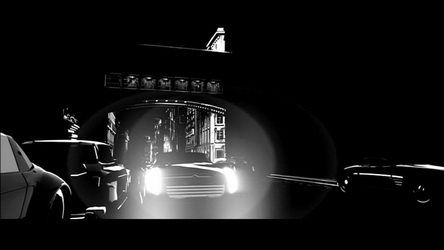 |
||||
Jane Wong Renaissance bases itself in the year 2054, where technology has advanced so far as to provide much more efficient and space-managing methods of communication, surveillance and architecture, but fails to deliver a new method of transportation within the city’s infrastructure. It seems strange that in such an advanced age, while although still based closely on the city’s original architectural basis (city blocks), the roads remain little changed, and the subway is still used and is identifiable to us. Furthermore, the cars also retain the same structure of cars we have today, posing the question as to whether the filmmakers chose to do this on purpose, and to what degree they are integral to the rest of the film.
|
|||||
| 18. | 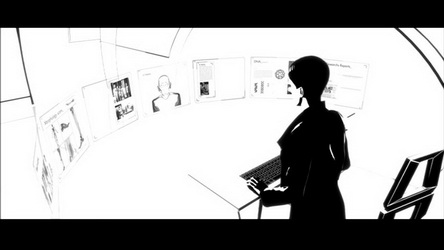 |
||||
Yoshi Hashimoto Renaissance is in every way a caricature- everything from the stark black and white artwork to the world-weary maverick gumshoe who gets suspended halfway through the story. The depiction of technology and the future itself is also a caricature- its key features distilled down to distinct polarities, with few shades of grey in between. Is that any better? Is it any less intrusive? One has to wonder at one point, how people have grown to accept it, or whether they even fully realize. One has to wonder if it is worth the exchange- loss of privacy for the promised security from crimes and other problems of society. Has it worked, is there any less crime in that society as compared to what was known in the past? If this technology is available to the authorities, how do we know that it will not be used for nefarious purposes, or by the "bad guys"? This dilemma of a double edged sword is parallel to the issue of immortality. If one has never pondered the necessity of some of lifes unpleasantries and contrasts, they should, and this film makes the case for it. We need dark as much as we need light, unconscious as much as conscious. Cold for hot, noise for quiet, and of course, death as much as life. Technology becomes a caricature for ends becoming a means.
|
|||||
| 19. | 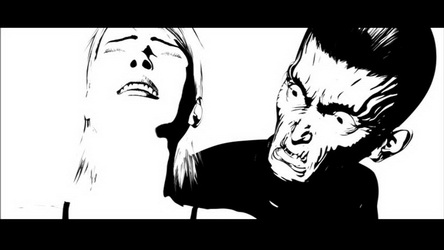 |
||||
Elfie Kalfakis The city of Paris, as depicted in Renaissance 2054, is under constant and intrusive surveillance by an overarching company, Avalon, involved with genetic modification research. The company prides itself on being a reliable authority to its people, but is actually a corrupt organization with an ultimate goal of finding immortality through genetic modification. The company puts on a façade to its public to hide aspirations for personal gain. Ilona Tasuiev is a well respected genetic researcher for Avalon. She is depicted as a well-to-do young girl with superior intelligence. She has a pristine ideal beauty. The plot revolves around rescuing Ilona after she is kidnapped. The reason for her kidnapping unfolds but isn’t clear until the movies end. Initially we assume she is kidnapped by Avalon members. Then we realize she is kidnapped by a close friend of hers in Avalon. We realize Ilona uncovered the secrets of Avalon’s failed experiements and assume the kidnapping was to prevent the leaking of information. As the plot unfolds we realize the kidnapping is an attempt to save Ilona from being used by Avalon to achieve their goals of immortality. After Illona is rescued, she reveals that she is aware of the secret quest towards immortality and suffers from the same corruption as the members of Avalon; she too aspires towards this goal. The entire movie revolves around the theme of deception. The idea of facades resonates if we look more closely at the depiction of faces. Ilona is a seemingly dignified character, but by the end of the movie we realize she is just as corrupt as the authority figures of Avalon. The people who are honest, and hold the truth about Avalon’s failed experiments are either well aged or disfigured. The logo/ spokes person for Avalon is a digital image of a woman, whose face morphs from a ragged aged face into a flawless complexion. The advertisements promote reliability to Parisians, but the fact that the spokes model is morphing while doing so is suspicious. So, what’s interesting is that the ‘pristine mask’ that is worn in this movie to hide personal motives not only deceives the characters, (logo), but also the audience, (Ilona). This adds a level of empathy. Our sense of ideal beauty does not register as a good thing to the audience. By the end of the movie we realize the only ‘good’ people in the movie are not necessarily the ‘beautiful’ people. The physical representations of the characters are usually in contrast to their ‘inner persons’. So not only is ideal beauty used as a vessel for deception, but also a commentary on the superficiality of physical appearance. What’s also interesting is in a city where one is constantly being watched, the sophistication of creating a mask for oneself could go as far as a genetic modification of one’s appearance. Avalon is endorsing a genetically modified beauty, where everyone in the city will have an ideal face. For the most part the faces within the movie are not well rendered. The eyes are the most expressive part of the face. In the production process, the actors wore goggles that would graph eye expressions, that was the only part of the face that was captured. The idea that the only parts of the human face that are distinguishable are the eyes suggests‘facelessness’ towards the citizens. Eyes have always been a symbol of truth, or as the entry point of a person’s soul. The rendering of the faces of the characters blankly, with vivid eyes adds to the interpretation of superficiality. Where the faces, or whatever masks worn, cannot rebut the inherent truth each character.
|
|||||
| 20. | 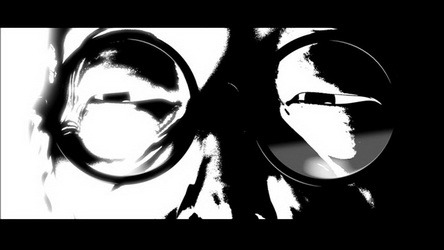 |
||||
Elaine Lui In a future Paris rendered in black and white with Computer Animation using motion picture capture of theatre performers, the movie directed by Christian Volckman entitled Renaissance is unique in its creation. Particularly in capturing the human eye in computer graphics, Volckman has added a soul to each of his characters while drawing the audience into the drama of the plot.
|
|||||
| 21. | 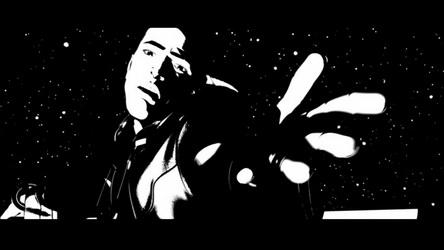 |
||||
Reggie Macintosh Renaissance 2054, a film created using both live and computer generated actors, emotes a level of emotion much higher than most other CG creations. Set in “The City of Light”, there are preconceived notions of romance and excitement attached to Paris. Yet the emotions exuded in this film lie at the more carnal of levels, driven by the abduction of a beautiful woman. The success of emotional portrayal in this film hinges on several elements: the graphic quality of the presentation, the believability of the characters’ movements, and the body language between characters. Though the quality, believability, and realism of CG animation and graphics has advanced tremendously since its inception, the human eye is still able to discern what has been filmed live action and what has been created in a computer. The ‘graphic novel’ style of Renaissance (high contrast black and white) does not allow the audience to scrutinize the CG characters in terms of their ability to portray real people as they have already been abstracted. In this decision, the artists working on the film have been freed to focus more attention on portraying emotional responses from the characters. It is a case of ‘less is more’ in terms of reducing the characters down to their essential qualities and using what is left to tell a compelling, emotional story. One of the most striking elements in the film was the believability of the characters’ movements. As a real person acted out each role in Renaissance with their movements recorded into the computer, the animators’ job has become much easier to allow the characters to move. It is in the personality, the small nuances, and the involuntary twitches of the actors that truly bring this animation to life visibly and emotionally. During a discussion between the sister and principal investigator, she brings her knees to her chest, letting a shoe fall to the floor while stubbing out a cigarette. This single series of movements shows more about her mood than any dialogue could have or even a facial reaction. A good actor is someone who can both deliver lines in a believable manner as well as move their body in way that describes the true meaning behind the words. This holds true for animation as well. Body language between characters follows the same line of discussion. Emotion comes from not only what we say but also how we physically interact with other people. Our movements toward another person or simply while talking to another person can tell a completely different story than the one we are verbalizing. So, the believability of body language in Renaissance is just as important to portraying emotion as the dialogue is to advancing the plot. Renaissance 2054 successfully used CG animation to create a world filled with excitement, drama, and emotion. It did so by creating an atmosphere of believability in the movements of the characters, and their graphic depiction. Limiting the palette of representation to black and white and emotionally rich movements allows the audience to lose itself in this futuristic vision of Paris where eternal youth is at our fingertips but is the last thing we want.
|
|||||
| 22. | 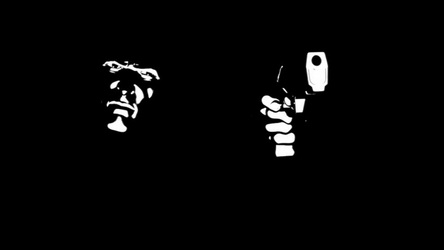 |
||||
Judith Martin Generally violence in films is depicted as a disturbing act rooted by evil. The violent scenes in Renaissance deviate from the generic methods of portraying evil by using the technique of motion capture. The motion capture technique essentially strips the visuals into a simplistic composition flattening each image of violence into a romanticized gesture of hostility. This can be contrasted to the naked acts of violence depicted in Clockwork Orange. The druids in clockwork orange commit brutal and grotesque acts of violence towards one another and towards society. These acts are often accompanied by bloodshed and other violent graphic content and are depicted with lots of colour, varying angles and close-ups. Violent instances in Renaissance feature far less of the grotesque and varying perspectives of each instance but instead focus on the basic actions portrayed using exaggerated film techniques to strengthen the visual essence of the act. A man aiming a gun is visually simplified with a high contrast silhouette of the light touching each surface. This reveals a sinister outlined face, a clenched hand at the end of a barrel. This scene is then given an exaggerated perspective to emphasize the importance and significance of the gun itself. The scene is stripped of all ornament and extravagance resulting in a celebration of the image of violence itself. The image is one of momentum and power depicted through the suspense of the un-pulled trigger, the image is pure: a man holding a trigger peering down the site of the gun with no intention of changing his mind. Rather than having an undertone of the insane and mad that Clockwork Orange had, the violent acts in Renaissance are fed through a filter of romance allowing the event of violence to be appreciated at a heightened state.
|
|||||
| 23. | 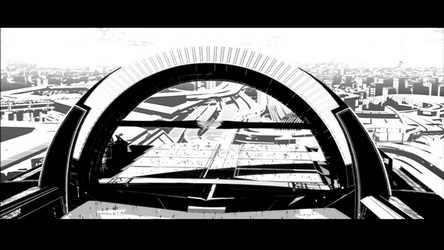 |
||||
Derek McCallum The setting of Renaissance in 2054 Paris provides an extremely interesting and original view of a potential social/economic as well as urban future. Firstly, the idea of an overbearing and oppressive state machine that rules over its citizens is absent, which differs from Brazil, Alphaville, and Equilibrium. A tyrannical corporate CEO instead replaces it. The company Avalon pushes beauty and “longevity” products on its customers and goes to extreme lengths to protect both its secrets and its interests. It’s advertising dominates the billboard landscape and seems inescapable. However, the social organization of this future seems to be relatively libertine and people may go about their lives, and even though Avalon is shown to be extremely powerful that power is largely confined to the realm of its products. In this future, corporate interests trump any form of government power. The urban future illustrated in the film is also unique in comparison to other films viewed during the term. There is an intense desire to create a city that feels like it has grown from its original form and retains some of the genius loci of that place. The image of Haussmann-era buildings flanking wide boulevards is clearly still evident, as is the Sacre Coeur perched atop the Montmartre. Even the subway trains speak of present-day Paris right down to the abundant graffiti. These indicators of the city’s intense sense of character lend the future image of Paris more credibility and interest. I find that the development of the city in the negative, below-grade, as opposed to the more often used skyscraper image is extremely effective. It reveals some of the innards of the city; especially the subway trains bursting from underground out over the deeply recessed Seine, or the various levels of highways that cling to the edge of the river embankment beneath glass-floored walkways. New architecture appears largely as parasitic-type small-scale interventions attached to and around the existing fabric. This richly layered image of present and future presents a much more fulfilling and meaningful image of 2054 Paris than had it been envisioned as one great futuristic place devoid of all the character that makes Paris so unique and recognizable. One of the few entirely “new” spaces in Paris is the Avalon headquarters, which appears as a great arch hovering over an immense public plaza. This future Arc de Triomphe would seem to replace the original and confirm the dominance of corporate interests over the state.
|
|||||
THE QUESTIONS BELOW DEAL DIRECTLY WITH THE MAKING OF THE FILM AND THE EFFECTS THAT THESE ISSUES HAVE ON THE FEELINGS OR REPRESENTATION OF MADNESS IN THE FILM. |
|||||
| 24. | 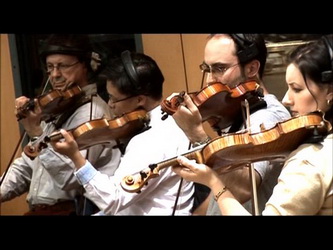 |
||||
Sarah Neault The musical score of Renaissance plays two key roles in contributing to the sense of madness in the film. First, the classical score grounds the film in a traditional film score which contrasts with the experimental visuals. Second, the original score reinforces the emotions induced in the audience by the characters and set and elevates the relationship of the three (sound, character, and set) to a surreal experience. The visual style of the film is highly experimental and thus challenges the audience’s sense of reality and sanity. The classical musical score, on the other hand, is familiar to the audience and understandable - which makes it ‘sane’. The tension between these two coincident states is much more powerful than either alone. The nuances of the original score, which is highly expressive, both reinforces and contrasts the relative realities of the set and the characters. These three levels of communication with the audience slip and slide between real and surreal sometimes reinforcing one another and sometimes chafing against one another. That interaction is what creates a genuine sense of madness - both felt and represented - in the film.
|
|||||
| 25. | 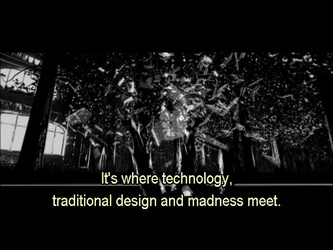 |
||||
Lisa Rajkumar-Maharaj The emotive effect of the film Renaissance can be described as being a semi-realistic dream in which parts of our world have descended into a kind of madness that is terrifyingly fathomable. The Avalon Company which seems to be most closely linked to the idea of a government sells beauty. The story alludes to the danger of trying to create a more beautiful human and that living as cerebral constructs that deny our innate human-ness inevitably makes our existence a mad one. The director achieved these effects through his graphic cinematic style as well as in his selection of location and the genre of his visual effects. The graphic style used in the movie establishes a surreal quality of existence for the characters in the film, which seems neither real, nor totally animated. It is between live action and animation and immediately creates a disturbing but seductive sense of madness or dissonance. The selection of Paris as the city of origin in this particular film, broadens the tradition of dytopic films borrowing the sets of existing cities. The selection of Paris is interesting because it is iconographically one of the most beautiful cities in the world. Having this dystopia projected on Paris, therefore creates a remarkable myth based purely on that of the existing city. The effect is believability as well as disharmony between the Parisian ideal and the ‘reality’ portrayed in the film. Alongside the selection of city and the graphic style of the movie, it is important to look at the genre of cinematic style this film engages, which is in part Film Noir. Film Noir, developed in 1940’s and 50’s looks at sex, violence and crime with dreamlike and yet brutal eyes that borrow from German Expressionistic black and white films. There is something intangible and different about film noir that is achieved through its ambiguous presentation of lurid lifestyles and acts in almost casual ways. This style accentuates the traditional Parisian charm and helps to build the main character, Karas into the detective hero. Within this style, with a praise of the unintentionally ugly, there is an opposition drawn to the Avalon Company which prizes beauty. A more melancholic, troubled or jaded beauty is evoked in the main characters, with generic beauty becoming something to be careful of.
|
|||||
| 26. | 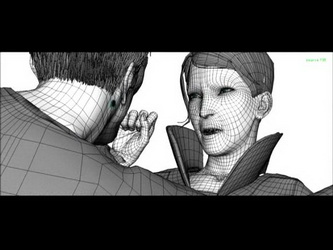 |
||||
| Michael Taylor "motion capture" |
|||||
| 27. | 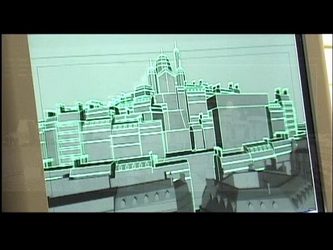 |
||||
Allison Janes The first time I saw Renaissance film I was living and working in Paris. I spent most of the film watching the animation of the city, looking for landmarks that I recognized and seeing how they were re-interpreted. It is apparent the animators wanted Paris to be a main character of the film. They capture the unique personality of Paris as we know it – a city with generations of history, Haussmann boulevards, art and café culture, and speculate how this unique character would evolve over 48 years, in which time there has been massive expansion in the built environment as well as the scars of war. The development and animation of the settings chosen by the production team reinforce the link between the spirit of the existing city and the madness of Paris in the future. The production team did not create an entire three-dimensional model of Paris; instead, they specifically chose the districts, monuments, and architectural detail that embody the character of Paris they wished to represent and animated it specifically. This demonstrates the distinct knowledge and attitude the animators, as Parisians have toward the contemporary city. They understood the unique moods of each district. For instance, the dark and dingy character underneath the bridges of the Seine or the madness of flashing lights, cabaret girls and strip shows in the Picalle district. The animators were able to manipulate these existing environments to best express the chaos and corruption of Paris in the movie. Therefore, the Paris depicted in Renaissance is not dependent on the existing conditions but on the memories and spirit the contemporary city embodies, and the creativity this inspires in the animators. Additionally, the animators have taken contemporary conditions, such as the disconnection between inner Paris and the surrounding suburbs, and speculated on the evolution of this urban relationship. Paris in 2054 has constrained its borders and retreated from its surrounding context. The Rue Peripherique (peripheral highway) has become a fortress wall with steep sloping sides built of stone and metal. To accommodate the finite borders of the city, Paris is built up and dug down. Glass cubes rise above historical buildings with their steel supports (clearly influenced by the steel architecture of the Eiffel Tower) cutting straight through the old structures. Dark underground tunnels create a labyrinth below the historical city and the metro. It is as if expansion has eaten away at historical and contemporary Paris, threatening the very foundations that support it. The bones of the city remain - the historical buildings and boulevards of Haussmann, the Seine, the Metro and the iconic medieval architecture. They are the remnants of the city spirit of Paris as it once was and contrast the mad evolution of urban relationships currently present in Paris. In conclusion the animators were able to describe the madness of Paris in 2054 without losing or diminishing the existing spirit of the city by incorporating and expanding on the existing character of Paris. They used their unique knowledge of the city to render the specific architectural forms, details and urban relationships of the existing city, with their representation of a chaotic future. |
|||||
| 28. | 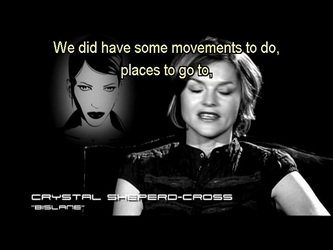 |
||||
Allan Wilson As a technique, motion capture allows for a seemingly more efficient method of animating scenes, as well it generates opportunities for greater visual emphasis and artistic experimentation to be investigated in each scene. In Renaissance, this is presented through the construction of a synthetic and richly layered Paris and insertion of “live action” therein. There are several ways in which this process of MOCAP animation could potentially feed into the theme of madness in Volkman’s film. |
|||||
updated 19-Dec-2008 6:02 PM